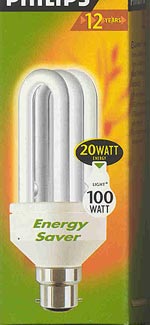Energy Saving Bulbs Pose Health Risks At Work And Home
 The government is planning to prevent the sale of conventional bulbs by 2011 to cut carbon dioxide emissions, and replace them with energey saving bulbs. They use approximately a quarter of the energy of conventional bulbs, and in September, Environment Secretary Hilary Benn said that a voluntary agreement with retailers would remove all conventional bulbs from the shops by December 2011.
The government is planning to prevent the sale of conventional bulbs by 2011 to cut carbon dioxide emissions, and replace them with energey saving bulbs. They use approximately a quarter of the energy of conventional bulbs, and in September, Environment Secretary Hilary Benn said that a voluntary agreement with retailers would remove all conventional bulbs from the shops by December 2011.
However, the switch to energy-saving light bulbs may put thousands at risk of painful skin reactions, health charities warn.
Fluorescent bulbs can exacerbate skin rashes in people with photosensitive skin conditions.
The Migraine Action Association also has concerns and says fluorescent bulbs have led to attacks, and cConcerns have already been raised by epilepsy charities about an increased risk of seizures from energy-saving bulbs.
Some bulbs use similar technology to fluorescent strip lights, and some users have complained that there can be a "flickering" effect. DSE users have also been wanred about screen flicker, which can in certain circumstances also effect people with epilepsy or a form of it called photo sensitive epilepsy. This is why news media warn viewers whenever items contain a lot of flash photography.
Karen Manning, from the Migraine Action Association, said that up to six million people in the UK suffer from some sort of migraine attack.
"These bulbs do trigger migraines for some of our members - it's either the flickering, or the low intensity of the light, causing eye strain. We would ask the government to avoid banning them completely, and still leave some opportunity for conventional bulbs to be purchased."
The British Association of Dermatologists is among several gropups that have called for exemptions to allow those affected to continue using traditional bulbs.
It has been estimated about 100,000 people in the UK with these skin conditions will be affected.
Spectrum - an alliance of charities that support people with light sensitive conditions - says they have also been contacted with people suffering from ME who have had bad reactions to fluorescent light.
Conventional or "incandescent" bulbs are being phased out in a voluntary agreement with retailers and will no longer be on sale from December 2011.
Campaigners want people who have light sensitive conditions to be able to continue to buy conventional bulbs for their homes.
They warned that employers must also be able to purchase incandescent lighting as employees have a right to such adjustments under the terms of the Disability Discrimination Act.
Andrew Langford, chief executive officer of the Skin Care Campaign, one of the charities involved, said:
"Incandescent light bulbs are the only source of electric light for many thousands of people with light sensitive conditions. Add to this the thousands of people whose conditions or treatments may secondarily cause them to be light sensitive, and you have a large number of people potentially being isolated in the dark. We certainly don't want to say no to greener bulbs just that other bulbs need to be available. It's hard for people to understand what it's like to live with one of these conditions."
He also called for a government-funded study into the effects of fluorescent lighting on photosensitive conditions as little research had been done to date.
"We have the anecdotal information - it's a shame people don't listen to those affected.
Dr Colin Holden, President of the British Association of Dermatologists, said:
"It is important that patients with photosensitive skin eruptions are allowed to use lights that don't exacerbate their condition. It is essential that such patients are able to protect themselves from specific wavelengths of light emitted by fluorescent bulbs, especially as they are often trapped indoors because they can't venture out in natural sunlight."
Kevin Verdun, chief executive of the lighting association said only two-thirds of incandescent bulbs were being phased out. These things have been taken into consideration and there will be bulbs they can still use. There are also halogen bulbs and LED bulbs coming in in the next two or three years."
However, the Lighting Association, which represents bulb manufacturers, said that the latest energy-saving bulbs did not produce a flicker.
A spokesman said: "A small number of cases have been reported by people who suffer from reactions to certain types of linear fluorescent lamps. These were almost certainly triggered by old technology."
Last year the charity Epilepsy Action reported that a small number of people with the illness could have seizures triggered by low-energy bulbs.
Health conditions which can involve some form of light sensitivity, include the auto-immune disease lupus, the genetic disorder Xeroderma Pigmentosum (XP), certain forms of eczema and dermatitis, photosensitivity, and porphyria.
It has been estimated about 100,000 people in the UK with these skin conditions will be affected.
Source: BBC News On-line